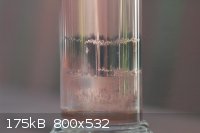arclight
Harmless

Posts: 4
Registered: 19-8-2012
Location: Vermont, USA
Member Is Offline
Mood: No Mood
|
|
OTC Copper Mirror
Quote: Originally posted by bfesser  | | arclight, please post details in another thread. I'm interested in exactly how you produced the Cu mirror band. |
Please understand this was not a well controlled experiment but, rather, grew out of a demo for my daughter. Hence the quantities where not measured.
I had read on this forum about the use of Ascorbic acid to reduce Copper II to elemental Copper in a fine powdered form. Further investigation yielded
several papers on various techniques of generating Copper nanoparticles and/or colloidal suspensions. That set me off down the path to try do the
classic Copper mirror experiment using Ascorbic acid as a more benign (and easily available) reducing agent.
I began with ~30 ml of saturated Copper Sulfate solution. To this I added enough 10% Ammonium Hydroxide to just dissolve the precipitate formed. Then
~ 1 gram of Ascorbic acid was added (the exact quantity I am unsure of). This did not completely dissolve and yielded some evolution of gas. I suspect
that not all the hydroxide precipitate had dissolved and as such reacted with the Ascorbic acid. This formed a milky colored layer just above the
undissolved Ascorbic acid due to turbulent mixing I assume. Within a few minutes the blue Copper II color completely disappeared and the solution was
water clear (except the bottom "milky" layer). At this point the cylinder was immersed in boiling water. Almost immediately the solution begins to
turn brown and darken. This is I believe colloidal Copper. The Ammonium complex is apparently important for limiting the particle size, at least that
what the literature suggests. Withing a few more minutes the mirror layer began to form just above the milky bottom layer. Within 10 minutes all was
done with the solution remaining a dark brown. The mirror turned out be quite tenacious and could not be wiped off but required an HCl/H2O2 etch to
remove it. This was surprising given that I didn’t do anything special to clean the glassware prior to the experiment.
I have been only partially successful in repeating this experiment. Currently I am awaiting the delivery of more Ascorbic acid before I can continue.
It seems that the interface between the saturated Ascorbic acid layer and the solution just above it holds the key.
That's it - lots of words but not much useful information 

[Edited on 21-8-2012 by arclight]
[Edited on 21-8-2012 by arclight]
[Edited on 21-8-2012 by arclight]
|
|
|
bfesser
Resident Wikipedian
    
Posts: 2114
Registered: 29-1-2008
Member Is Offline
Mood: No Mood
|
|
Thanks for the writeup. What is your source of ascorbic acid?
|
|
|
arclight
Harmless

Posts: 4
Registered: 19-8-2012
Location: Vermont, USA
Member Is Offline
Mood: No Mood
|
|
Local "healthy foods" store, USP grade "Vitamin C" powder. ~$12 US for 8 oz., rather pricey IMO
For a few dollars more (including shipping) I just received a kilo of it from an EBAY seller.
|
|
|
detonator
Harmless

Posts: 29
Registered: 12-4-2011
Location: Maoming City, Guangdong Province, China.
Member Is Offline
Mood: No Mood
|
|
Recommended try using hydrazine hydrate, this can also be successful.
|
|
|
arclight
Harmless

Posts: 4
Registered: 19-8-2012
Location: Vermont, USA
Member Is Offline
Mood: No Mood
|
|
I realize that Hydrazine salts can be used, as well as Hydroxylamine Hydrochloride.
I posted this as a possible OTC alternative to the above more difficult to acquire reagents.
|
|
|
annaandherdad
Hazard to Others
  
Posts: 387
Registered: 17-9-2011
Member Is Offline
Mood: No Mood
|
|
arclight, your experience with copper reminds me of the silver layer produced by the Brashear process, which uses glucose as the reducing agent on an
ammonia complex of silver hydroxide. The Brashear silver layer is very tough, an advantage for telescope mirrors where it must be polished
periodically to remove the tarnish. I have found that the Brashear layer of silver cannot be removed with a razor blade, instead I have had to use
nitric acid.
The process is also very fussy, and won't work unless conditions are just right (very clean glass, very pure reagents). Maybe it's related to your
difficulty in reproducing your results.
Have you done anything more recently with copper mirrors? I might be interested to try reproducing what you have done.
Any other SF Bay chemists?
|
|
|